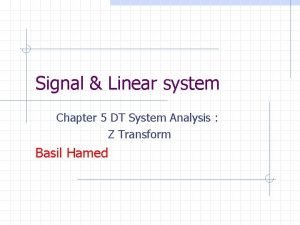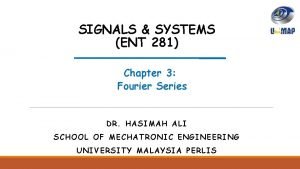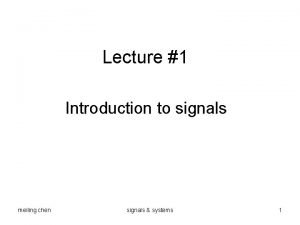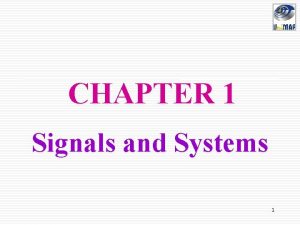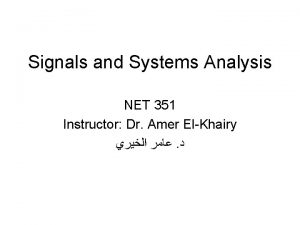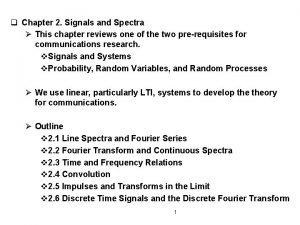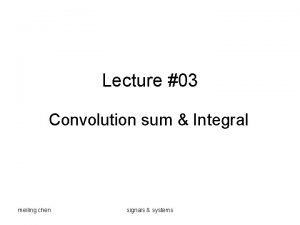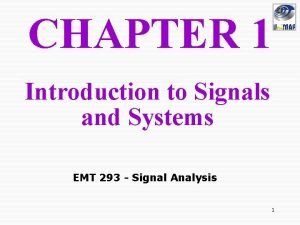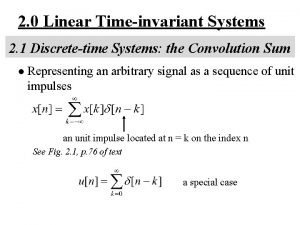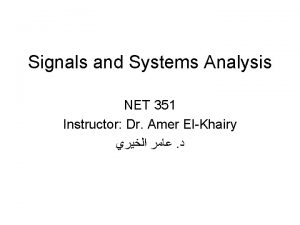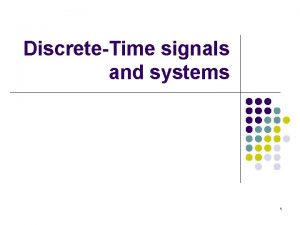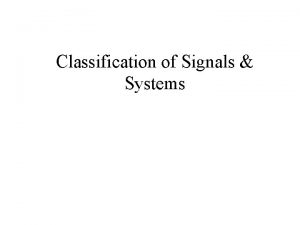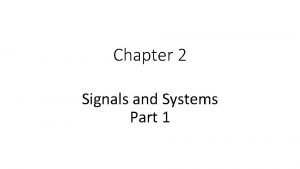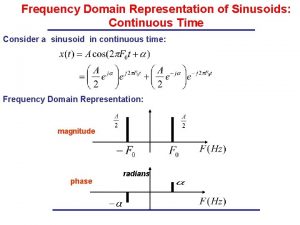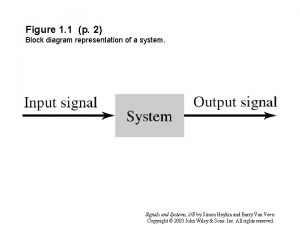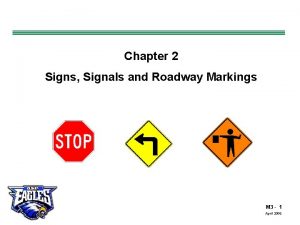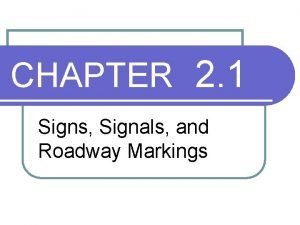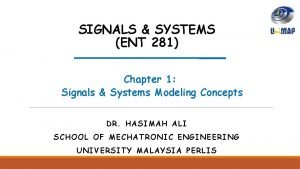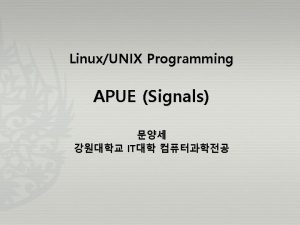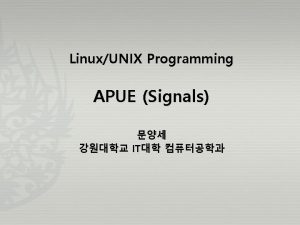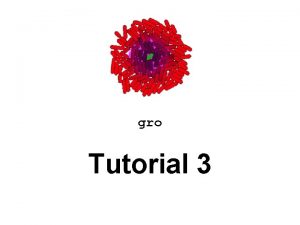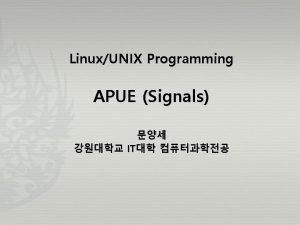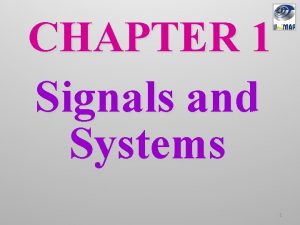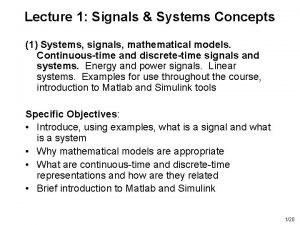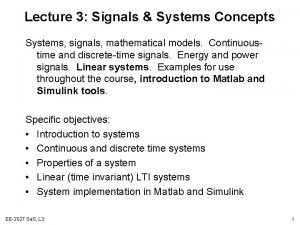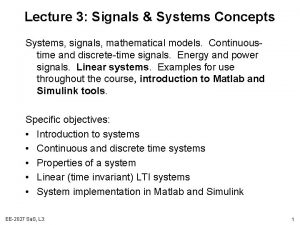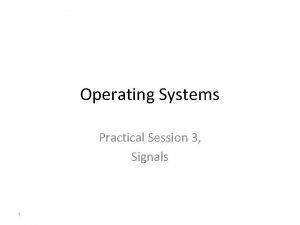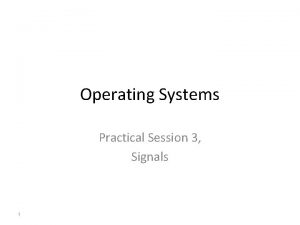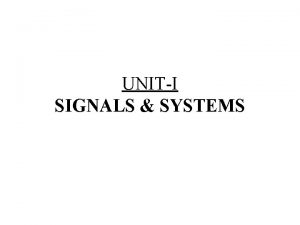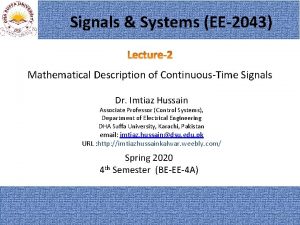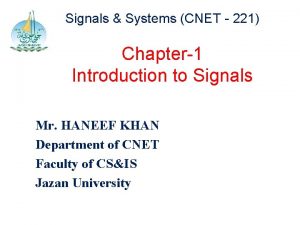Chapter 2 Signals and Systems Part 1 Signals






















- Slides: 22

Chapter 2 Signals and Systems Part 1

Signals and Systems • A signal is a real (or complex) valued function of one or more real variables. • • • voltage across a resistor or current through inductor pressure at a point in the ocean amount of rain at 37. 4225 N, 122. 1653 W amount of rain at 16: 00 UTC as function of latitude, longitude price of Google stock at end of each trading day In this course the independent variable is almost always time. • Physical signals have units, e. g. , volts or psi (Si pascal = N/m 2) • • 2/23/2021 Signals can (usually or in principle) be measured: g(t) 7→ g(0) g(t) 7→ R-∞ ∞ g(u) du (area) g(t) 7→ R-∞ ∞ |g(u)|2 du (energy) The mathematical term for a measurement is functional. Chapter 2: Signals and Systems 2

Signals and Systems (cont. ) • A system is an object that takes signals as inputs and produces signals as outputs. In general, the output signal depends on entirety of input signal; e. g. , • • Examples of physical systems: • Electrical circuit: voltage in, voltage or current out • Building: earth shaking in, building shaking out • Audio amplifier 2/23/2021 Chapter 2: Signals and Systems 3

Signal Energy and Power • A signal is periodic if it repeats: for every t. E. g. , sin(t) has period 2π and tan(t) has period π. • The power of a periodic signal g(t) is where T is the period of g(t). If g(t) is complex valued, then |g(t)|2 is the square of magnitude/modulus. • The power of a general signal is a limit: This limit may be zero. E. g. : 2/23/2021 Chapter 2: Signals and Systems 4

Signal Energy and Power (cont. ) • The energy of a signal g(t) is: We are interested in energy only when it is finite. Common cases: • Bounded signal of finite duration; e. g. , a pulse • Exponentially decaying signals (output of some linear systems with pulse input) • Necessary conditions for finite energy. • The energy in the “tails” of the signal must approach 0: • We would expect that the instantaneous power |g(t)|2 → 0, but that is not required. (This is only of mathematical interest. ) 2/23/2021 Chapter 2: Signals and Systems 5

Units of Power • If a signal g(t) measured in volts is applied to a load resistor R, then the power in watts is: Normally we do not care about the load, so we normalize to R = 1. • In many applications, the effect of the signal varies as the log of the signal; e. g. , human hearing and sight. • Power can be expressed in decibels (d. B), which are logarithmic and relative to some standard power. If P is measured in watts, then • Power in d. BW is 10 log 10 (P) (power relative to 1 W) • Power in d. Bm (or d. Bm. W) is log 10(1000 P ) = 30 + 10 log 10 P • One bel (B) is too large to be useful. The bel is named for Alexander Graham Bell (1847– 1922). The d. B was adopted by NBS in 1931. It is not an SI unit. 2/23/2021 Chapter 2: Signals and Systems 6

Classification of Signals • Signals can have a variety of characteristics, including • values can be continuous or discrete • continuous or discrete time variable • deterministic or random • For deterministic signals, we have four cases: • • continuous time, continuous valued (mathematics) continuous time, discrete valued discrete time, continuous valued (digital signal processing) discrete time, discrete valued (digital switching) • Time can be restricted to a finite interval (e. g. , one period) 2/23/2021 Chapter 2: Signals and Systems 7

Classification of Signals (cont. ) 2/23/2021 Chapter 2: Signals and Systems 8

Operations on Signals • Time shifting/delay: g(t ± T ) 2/23/2021 Chapter 2: Signals and Systems 9

Operations on Signals 2 • Time scaling: g(at) stretches (0 < a < 1) or squeezes (a > 1) 2/23/2021 Chapter 2: Signals and Systems 10

Operations on Signals 3 • Time reversal: g(-t) • Each of these operations corresponds to a linear system 2/23/2021 Chapter 2: Signals and Systems 11

Unit Impulse Signal • Most physical systems give the same output for any narrow pulse with a given area. • The abstraction of a infinitely narrow signal with area 1 is the unit impulse signal. Paul A. M. Dirac “defined” δ(t) by: • The area of the impulse is important; the energy of δ(t) is not defined. 2/23/2021 Chapter 2: Signals and Systems 12

Properties of Unit Impulse Signal • 2/23/2021 Chapter 2: Signals and Systems 13

Unit Step Function u(t) • The Heaviside unit step function is defined by The unit step function corresponds to turning on at time 0. • Unit step is integral of unit impulse: Oliver Heaviside (1850 -1925) was a self-taught English electrical engineer, mathematician, and physicist who adapted complex numbers to the study of electrical circuits, invented mathematical techniques to the solution of differential equations (later found to be equivalent to Laplace transforms), reformulated Maxwell’s field equations in terms of electric and magnetic forces and energy flux, and independently co-formulated vector analysis. 2/23/2021 Chapter 2: Signals and Systems 14

Periodic Signals • A signal g is called periodic if it repeats in time; i. e. , for some T > 0, g(t + T ) = g(T ) for all t. • If g is periodic, its period is the smallest such T. • Examples: trignometric functions are periodic. Period of cos t is 2π; period of tan t is π. • The period of g(mt) is T/m. E. g. , period of cos 2πft is 2π/f, and its frequency is f Hz. • If g and f are periodic, their common period is LCM(Tg, Tf ). E. g. , period of sin πt + sin 2πt/5 is LCM(2, 5) = 10. 2/23/2021 Chapter 2: Signals and Systems 15

Fourier Series • Periodic signals can be written as the sum of sinusoids whose frequencies are integer multiples of the fundamental frequency f 0 = 1/T 0. • The most general representation uses complex exponential functions. In general, the Fourier series coefficients Cn are complex numbers, even when the signal is real valued. • The Fourier series coefficients can be computed by The integral is over any period of the signal. 2/23/2021 Chapter 2: Signals and Systems 16

Fourier Series Alternative Forms • Euler’s formula ejθ = cos(θ) + j sin(θ) allows us to represent periodic signals as sums of sines and cosines: The coefficients are: • A third form is: Where each frequency component is described by an amplitude and a phase. 2/23/2021 Chapter 2: Signals and Systems 17

Fourier Series Examples 1: Sinusoids • Sinusoids have a finite number of terms. By Euler’s formula: Therefore: The Fourier exponential series coefficients are: and Note that power of cos or sin is: which is the (RMS value)2 2/23/2021 Chapter 2: Signals and Systems 18

Fourier Series Examples 2: A Square Wave • Square wave with period 2π defined over interval [-π, π] by Fourier series coefficients: if n > 0, 2/23/2021 Chapter 2: Signals and Systems 19

Square Wave (cont. ) The overshoot is an example of the Gibbs’ phenomenon. The overshoot is ≈ 9% and occurs no matter how many terms are used. 2/23/2021 Chapter 2: Signals and Systems 20

Fourier Series Examples 3 Trigonometric function: tan(t): First term: Second term: Combine terms: The Fourier series of this odd function has only even harmonics: A trigonometric series with many terms (not well behaved): 2/23/2021 Chapter 2: Signals and Systems 21

Types of Systems • For theoretical and practical reasons, we restrict attention to systems and have useful properties and represent the physical world. • • • Causal Continuous Stable Linear* Time invariant* • Fundamental fact: every linear, time-invariant system (LTIS) is characterized by • Impulse response: w(t) = h(t) ∗ v(t) • Transfer function: in frequency domain, W (f) = H(f) · V (f) * In this course we will sometimes relax these restrictions 2/23/2021 Chapter 2: Signals and Systems 22
 Signals and systems oppenheim solutions chapter 5
Signals and systems oppenheim solutions chapter 5 Communicative signals and informative signals
Communicative signals and informative signals What was the first human language
What was the first human language Communicative and informative signals
Communicative and informative signals Series de fourier
Series de fourier Signals
Signals Precedence rule in signals and systems
Precedence rule in signals and systems Convolution sum in signals and systems
Convolution sum in signals and systems Synthesis equation fourier series
Synthesis equation fourier series Convolution integral
Convolution integral Introduction to signals and systems
Introduction to signals and systems Convolution sum in signals and systems
Convolution sum in signals and systems Signals and systems
Signals and systems Signal and systems
Signal and systems Tri function
Tri function Signal and systems
Signal and systems Time frequency
Time frequency Signals and systems
Signals and systems Chapter 2 signs signals and roadway markings
Chapter 2 signs signals and roadway markings Chapter 2 signs, signals, and roadway markings
Chapter 2 signs, signals, and roadway markings A signal that alerts drivers to dangerous conditions
A signal that alerts drivers to dangerous conditions Signs signals and pavement markings
Signs signals and pavement markings A short section of corrugated roadway
A short section of corrugated roadway
